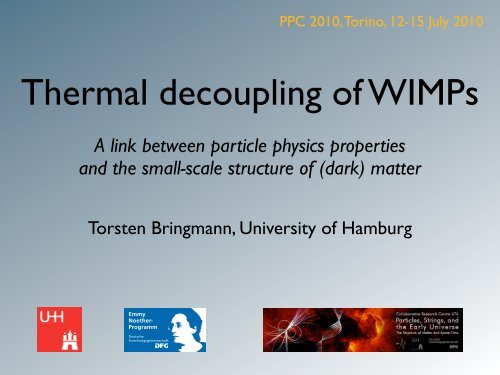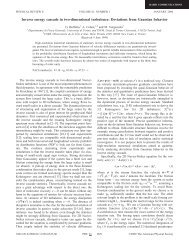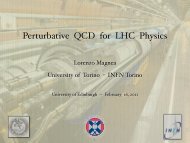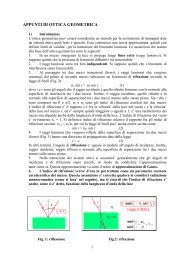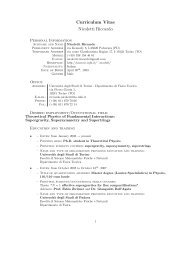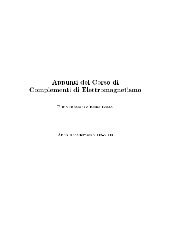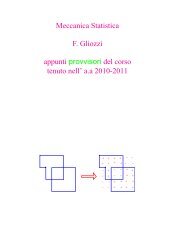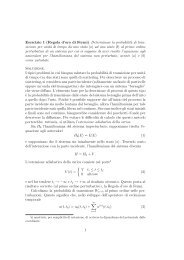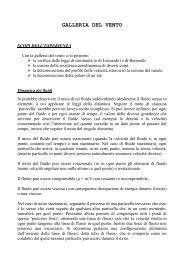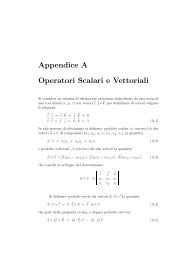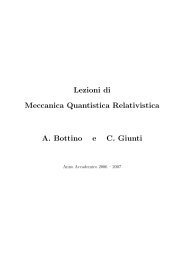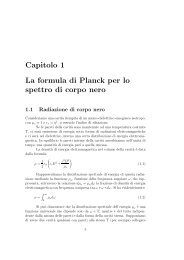Thermal decoupling of WIMPs - PPC 2010
Thermal decoupling of WIMPs - PPC 2010
Thermal decoupling of WIMPs - PPC 2010
Create successful ePaper yourself
Turn your PDF publications into a flip-book with our unique Google optimized e-Paper software.
<strong>PPC</strong> <strong>2010</strong>, Torino, 12-15 July <strong>2010</strong><br />
<strong>Thermal</strong> <strong>decoupling</strong> <strong>of</strong> <strong>WIMPs</strong><br />
A link between particle physics properties<br />
and the small-scale structure <strong>of</strong> (dark) matter<br />
Torsten Bringmann, University <strong>of</strong> Hamburg
Outlook<br />
Chemical vs kinetic <strong>decoupling</strong> <strong>of</strong> <strong>WIMPs</strong><br />
Kinetic <strong>decoupling</strong> from first principles<br />
The size <strong>of</strong> the first protohalos<br />
Observational prospects<br />
Conclusions<br />
Torsten Bringmann, University <strong>of</strong> Hamburg <strong>Thermal</strong> <strong>decoupling</strong> <strong>of</strong> <strong>WIMPs</strong> ‒<br />
2
Dark matter<br />
Existence by now (almost)<br />
impossible to challenge!<br />
Ω CDM =0.233 ± 0.013 (WMAP)<br />
electrically neutral (dark!)<br />
non-baryonic (BBN)<br />
cold ‒ dissipationless and negligible<br />
free-streaming effects<br />
collisionless (bullet cluster)<br />
(structure formation)<br />
credit: WMAP<br />
Torsten Bringmann, University <strong>of</strong> Hamburg <strong>Thermal</strong> <strong>decoupling</strong> <strong>of</strong> <strong>WIMPs</strong> ‒<br />
3
Dark matter<br />
Existence by now (almost)<br />
impossible to challenge!<br />
Ω CDM =0.233 ± 0.013 (WMAP)<br />
electrically neutral (dark!)<br />
non-baryonic (BBN)<br />
cold ‒ dissipationless and negligible<br />
free-streaming effects<br />
collisionless (bullet cluster)<br />
(structure formation)<br />
credit: WMAP<br />
WIMPS are particularly<br />
good candidates:<br />
well-motivated from particle physics<br />
[SUSY, EDs, little Higgs, ...]<br />
thermal production “automatically”<br />
leads to the right relic abundance<br />
Torsten Bringmann, University <strong>of</strong> Hamburg <strong>Thermal</strong> <strong>decoupling</strong> <strong>of</strong> <strong>WIMPs</strong> ‒<br />
3
The WIMP “miracle”<br />
iracle”<br />
IMP<br />
ed by<br />
)<br />
2<br />
eq<br />
a 3 nχ<br />
ls bee<br />
unithe<br />
relic<br />
The number density <strong>of</strong> Weakly Interacting Massive<br />
Particles in the early universe:<br />
n χ eq<br />
increasing〈σv〉<br />
time<br />
Fig.: Jungman, Kamionkowski & Griest, PR’96<br />
Jungman, Kamionkowski & Griest, PR ’96<br />
dn χ<br />
dt<br />
〈σv〉:<br />
+3Hn χ = −〈σv〉<br />
χχ → SM SM<br />
( )<br />
n 2 χ − n 2 χeq<br />
(thermal average)<br />
1) [for interaction strengths <strong>of</strong> the weak type]<br />
Torsten Bringmann, University <strong>of</strong> Hamburg <strong>Thermal</strong> <strong>decoupling</strong> <strong>of</strong> <strong>WIMPs</strong> ‒<br />
4
The WIMP “miracle”<br />
iracle”<br />
IMP<br />
ed by<br />
)<br />
2<br />
eq<br />
a 3 nχ<br />
ls bee<br />
unithe<br />
relic<br />
The number density <strong>of</strong> Weakly Interacting Massive<br />
Particles in the early universe:<br />
n χ eq<br />
increasing〈σv〉<br />
time<br />
Fig.: Jungman, Kamionkowski & Griest, PR’96<br />
Jungman, Kamionkowski & Griest, PR ’96<br />
Relic density (today):<br />
1) [for interaction strengths <strong>of</strong> the weak type]<br />
dn χ<br />
dt<br />
〈σv〉:<br />
+3Hn χ = −〈σv〉<br />
χχ → SM SM<br />
( )<br />
n 2 χ − n 2 χeq<br />
(thermal average)<br />
“Freeze-out” when annihilation<br />
rate falls behind expansion rate<br />
(→ a 3 n χ ∼ const.)<br />
Ω χ h 2 ∼ 3 · 10−27 cm 3 /s<br />
〈σv〉<br />
for weak-scale<br />
interactions!<br />
∼ O(0.1)<br />
Torsten Bringmann, University <strong>of</strong> Hamburg <strong>Thermal</strong> <strong>decoupling</strong> <strong>of</strong> <strong>WIMPs</strong> ‒<br />
4
Freeze-out = <strong>decoupling</strong> !<br />
WIMP interactions with heat bath <strong>of</strong> SM particles:<br />
χ<br />
SM<br />
χ χ<br />
χ<br />
(annihilation)<br />
SM SM (scattering) SM<br />
Torsten Bringmann, University <strong>of</strong> Hamburg <strong>Thermal</strong> <strong>decoupling</strong> <strong>of</strong> <strong>WIMPs</strong> ‒<br />
5
Freeze-out = <strong>decoupling</strong> !<br />
WIMP interactions with heat bath <strong>of</strong> SM particles:<br />
χ<br />
SM<br />
χ χ<br />
χ<br />
(annihilation)<br />
SM SM (scattering) SM<br />
Boltzmann suppression <strong>of</strong> n χ<br />
scattering processes much more frequent<br />
continue even after chemical <strong>decoupling</strong> (“freeze-out”) at T cd ∼ m χ /25<br />
Torsten Bringmann, University <strong>of</strong> Hamburg <strong>Thermal</strong> <strong>decoupling</strong> <strong>of</strong> <strong>WIMPs</strong> ‒<br />
5
Freeze-out = <strong>decoupling</strong> !<br />
WIMP interactions with heat bath <strong>of</strong> SM particles:<br />
χ<br />
SM<br />
χ χ<br />
χ<br />
(annihilation)<br />
SM SM (scattering) SM<br />
Boltzmann suppression <strong>of</strong> n χ<br />
scattering processes much more frequent<br />
continue even after chemical <strong>decoupling</strong> (“freeze-out”) at T cd ∼ m χ /25<br />
Kinetic <strong>decoupling</strong> much later:<br />
τ r (T kd ) ≡ N coll /Γ el ∼ H −1 (T kd )<br />
Random walk in<br />
momentum space<br />
N coll ∼ m χ /T<br />
Schmid, Schwarz, & Widerin, PRD ’99; Green, H<strong>of</strong>mann & Schwarz, JCAP ’05, ...<br />
Torsten Bringmann, University <strong>of</strong> Hamburg <strong>Thermal</strong> <strong>decoupling</strong> <strong>of</strong> <strong>WIMPs</strong> ‒<br />
5
Kinetic <strong>decoupling</strong> in detail<br />
Evolution <strong>of</strong> phase-space density f χ given by the full<br />
Boltzmann equation in FRW spacetime:<br />
E(∂ t − Hp · ∇ p )f χ = C[f χ ]<br />
Torsten Bringmann, University <strong>of</strong> Hamburg <strong>Thermal</strong> <strong>decoupling</strong> <strong>of</strong> <strong>WIMPs</strong> ‒<br />
6
Kinetic <strong>decoupling</strong> in detail<br />
Evolution <strong>of</strong> phase-space density f χ given by the full<br />
Boltzmann equation in FRW spacetime:<br />
∫<br />
d 3 p<br />
E(∂ t − Hp · ∇ p )f χ = C[f χ ]<br />
recovers the familiar<br />
dn χ<br />
dt<br />
+3Hn χ = −〈σv〉<br />
(<br />
n 2 χ − n 2 χeq)<br />
...<br />
Torsten Bringmann, University <strong>of</strong> Hamburg <strong>Thermal</strong> <strong>decoupling</strong> <strong>of</strong> <strong>WIMPs</strong> ‒<br />
6
Kinetic <strong>decoupling</strong> in detail<br />
Evolution <strong>of</strong> phase-space density f χ given by the full<br />
Boltzmann equation in FRW spacetime:<br />
∫<br />
d 3 p<br />
E(∂ t − Hp · ∇ p )f χ = C[f χ ]<br />
recovers the familiar<br />
T χ n χ ≡<br />
Torsten Bringmann, University <strong>of</strong> Hamburg <strong>Thermal</strong> <strong>decoupling</strong> <strong>of</strong> <strong>WIMPs</strong> ‒<br />
dn χ<br />
dt<br />
d 3 p<br />
(2π) 3 p2 f χ (p)<br />
+3Hn χ = −〈σv〉<br />
∫<br />
(<br />
n 2 χ − n 2 χeq)<br />
...<br />
Idea: consider instead the 2 nd moment ( d 3 p p 2 )<br />
∫<br />
and introduce<br />
analytic treatment possible<br />
no assumptions about f χ (p) necessary<br />
Allows highly accurate treatment, to order O(T/m χ ) 10 −3<br />
Bertschinger, PRD ’06; TB & H<strong>of</strong>mann, JCAP ’07; TB, NJP ’09<br />
6
The collision term<br />
χ p<br />
SM<br />
k<br />
˜p χ<br />
˜k<br />
SM<br />
C =<br />
∫<br />
d 3 k<br />
(2π) 3 2ω<br />
∫<br />
d 3˜k<br />
(2π) 3 2˜ω<br />
∫<br />
d 3 ˜p<br />
(2π) 3 2Ẽ (2π)4 δ (4) (˜p + ˜k − p − k)|M| 2<br />
× g SM<br />
[(<br />
1 ∓ g ± (ω) ) g ± (˜ω)f(˜p ) − ( 1 ∓ g ± (˜ω) ) g ± (ω)f(p) ]<br />
g ± : thermal distribution<br />
Torsten Bringmann, University <strong>of</strong> Hamburg <strong>Thermal</strong> <strong>decoupling</strong> <strong>of</strong> <strong>WIMPs</strong> ‒<br />
7
The collision term<br />
χ p<br />
SM<br />
k<br />
˜p χ<br />
˜k<br />
SM<br />
C =<br />
∫<br />
d 3 k<br />
(2π) 3 2ω<br />
∫<br />
d 3˜k<br />
(2π) 3 2˜ω<br />
∫<br />
d 3 ˜p<br />
(2π) 3 2Ẽ (2π)4 δ (4) (˜p + ˜k − p − k)|M| 2<br />
× g SM<br />
[(<br />
1 ∓ g ± (ω) ) g ± (˜ω)f(˜p ) − ( 1 ∓ g ± (˜ω) ) g ± (ω)f(p) ]<br />
g ± : thermal distribution<br />
Expansion in ω/m χ ∼ T/m χ<br />
[<br />
]<br />
C ≃ c(T )m 2 χ m χ T ∆ p + p · ∇ p +3 f(p)<br />
c(T )= ∑ ∫<br />
g SM<br />
6(2π) 3 m 4 dk k 5 ω −1 g ± ( 1 ∓ g ±) |M| 2 t=0<br />
i<br />
χT<br />
Torsten Bringmann, University <strong>of</strong> Hamburg <strong>Thermal</strong> <strong>decoupling</strong> <strong>of</strong> <strong>WIMPs</strong> ‒<br />
7
The collision term<br />
χ p<br />
SM<br />
k<br />
˜p χ<br />
˜k<br />
SM<br />
C =<br />
∫<br />
d 3 k<br />
(2π) 3 2ω<br />
∫<br />
d 3˜k<br />
(2π) 3 2˜ω<br />
∫<br />
d 3 ˜p<br />
(2π) 3 2Ẽ (2π)4 δ (4) (˜p + ˜k − p − k)|M| 2<br />
× g SM<br />
[(<br />
1 ∓ g ± (ω) ) g ± (˜ω)f(˜p ) − ( 1 ∓ g ± (˜ω) ) g ± (ω)f(p) ]<br />
g ± : thermal distribution<br />
Expansion in ω/m χ ∼ T/m χ<br />
[<br />
]<br />
C ≃ c(T )m 2 χ m χ T ∆ p + p · ∇ p +3 f(p)<br />
c(T )= ∑ ∫<br />
g SM<br />
6(2π) 3 m 4 dk k 5 ω −1 g ± ( 1 ∓ g ±) |M| 2 t=0<br />
i<br />
χT<br />
Analytic solution if |M| 2 = |M| 2 0 (ω/m χ) 2<br />
∫<br />
generic situation for<br />
dk k 5 ... = N × |M| 2 0 m−2 χ T 7 m SM ≪ ω ≪ ω res<br />
Torsten Bringmann, University <strong>of</strong> Hamburg <strong>Thermal</strong> <strong>decoupling</strong> <strong>of</strong> <strong>WIMPs</strong> ‒<br />
7
The WIMP temperature<br />
T χ<br />
Resulting ODE for :<br />
4.5<br />
(<br />
dy<br />
dx =2m χc(T )<br />
1 − T χ<br />
H˜g −1/2 T<br />
T. Bringmann, 2009<br />
)<br />
y = mχg −1/2<br />
log 10<br />
(<br />
eff<br />
Tχ/T 2 )<br />
4.0<br />
3.5<br />
3.0<br />
2.5<br />
2.0<br />
1.5<br />
T χ ∝ a −2<br />
T χ = T<br />
x kd =m χ /T kd<br />
(T < T kd )<br />
(T > T kd ) Example:<br />
m χ = 100 GeV<br />
|M| 2 ∼ g 4 Y (E χ /m χ ) 2<br />
1.0<br />
2.0 2.5 3.0 3.5 4.0 4.5 5.0 5.5<br />
log 10 (x = m χ /T )<br />
Torsten Bringmann, University <strong>of</strong> Hamburg <strong>Thermal</strong> <strong>decoupling</strong> <strong>of</strong> <strong>WIMPs</strong> ‒<br />
8
The WIMP temperature<br />
T χ<br />
Resulting ODE for :<br />
4.5<br />
(<br />
dy<br />
dx =2m χc(T )<br />
1 − T χ<br />
H˜g −1/2 T<br />
T. Bringmann, 2009<br />
)<br />
y = mχg −1/2<br />
log 10<br />
(<br />
eff<br />
Tχ/T 2 )<br />
4.0<br />
3.5<br />
3.0<br />
2.5<br />
2.0<br />
1.5<br />
T χ ∝ a −2<br />
T χ = T<br />
x kd =m χ /T kd<br />
(T < T kd )<br />
(T > T kd ) Example:<br />
m χ = 100 GeV<br />
|M| 2 ∼ g 4 Y (E χ /m χ ) 2<br />
1.0<br />
2.0 2.5 3.0 3.5 4.0 4.5 5.0 5.5<br />
log 10 (x = m χ /T )<br />
Fast transition allows straight-forward definition <strong>of</strong> T kd<br />
TB & H<strong>of</strong>mann, JCAP ’07; TB, NJP ’09<br />
Torsten Bringmann, University <strong>of</strong> Hamburg <strong>Thermal</strong> <strong>decoupling</strong> <strong>of</strong> <strong>WIMPs</strong> ‒<br />
8
T kd<br />
in SUSY<br />
Implement all SM-neutralino scattering amplitudes<br />
Scan MSSM and mSUGRA parameter space<br />
(~10 6 models, 3 σ WMAP, all collider bounds OK)<br />
T. Bringmann, 2009<br />
TB, NJP ’09<br />
T. Bringmann, 2009<br />
Tkd [MeV]<br />
10 3<br />
10 2<br />
10<br />
10 4 50 100 500 1000 5000<br />
Higgsino (Z g < 0.05)<br />
mixed (0.05 ≤ Z g ≤ 0.95)<br />
<br />
Gaugino (Z g > 0.95)<br />
<br />
<br />
<br />
<br />
<br />
<br />
<br />
⨯<br />
<br />
<br />
<br />
<br />
<br />
<br />
<br />
<br />
<br />
<br />
<br />
<br />
<br />
<br />
<br />
<br />
<br />
<br />
<br />
<br />
<br />
<br />
<br />
<br />
<br />
<br />
<br />
<br />
<br />
<br />
<br />
<br />
<br />
<br />
<br />
<br />
K <br />
<br />
<br />
⨯<br />
′<br />
<br />
<br />
<br />
<br />
<br />
<br />
<br />
<br />
<br />
<br />
<br />
<br />
<br />
<br />
<br />
<br />
⨯<br />
<br />
<br />
<br />
<br />
<br />
<br />
QCD<br />
<br />
<br />
<br />
<br />
I ′ J ∗ F ∗<br />
⨯<br />
<br />
<br />
xkd = mχ/Tkd<br />
10 4<br />
10 3<br />
<br />
<br />
<br />
Higgsino (Z g < 0.05)<br />
10 5 20 22 24 26 28 30<br />
mixed (0.05 ≤ Z g ≤ 0.95)<br />
Gaugino (Z g > 0.95)<br />
<br />
<br />
<br />
<br />
<br />
<br />
<br />
<br />
<br />
<br />
<br />
<br />
<br />
<br />
<br />
<br />
<br />
<br />
<br />
<br />
<br />
<br />
<br />
<br />
<br />
<br />
<br />
<br />
<br />
<br />
<br />
<br />
<br />
<br />
<br />
<br />
<br />
m χ [GeV]<br />
x cd = m χ /T cd<br />
Torsten Bringmann, University <strong>of</strong> Hamburg <strong>Thermal</strong> <strong>decoupling</strong> <strong>of</strong> <strong>WIMPs</strong> ‒<br />
10 2<br />
9
The smallest protohalos<br />
Free streaming <strong>of</strong> <strong>WIMPs</strong><br />
after washes out density<br />
contrasts on small scales<br />
t kd<br />
Loeb & Zaldarriaga, PRD ’05<br />
e.g. Green, H<strong>of</strong>mann & Schwarz, JCAP ’05<br />
Similar effect from<br />
baryonic oscillations<br />
Bertschinger, PRD ’06<br />
Cut<strong>of</strong>f in power spectrum<br />
corresponds to smallest<br />
gravitationally bound<br />
objects in the universe<br />
⎛<br />
M fs =2.9×10 −6 ⎜<br />
⎝<br />
(<br />
1 + ln<br />
(<br />
m χ<br />
100 GeV<br />
1<br />
g<br />
4<br />
eff T kd<br />
30 MeV<br />
M ao =3.4 × 10 −6 (<br />
T kd g 1 4<br />
eff<br />
50 MeV<br />
)<br />
/18.6<br />
) 1<br />
2<br />
g 1 4<br />
eff<br />
( Tkd<br />
30 MeV<br />
) 1<br />
2<br />
) −3<br />
M ⊙<br />
⎞<br />
3<br />
⎟<br />
⎠<br />
M ⊙<br />
Torsten Bringmann, University <strong>of</strong> Hamburg <strong>Thermal</strong> <strong>decoupling</strong> <strong>of</strong> <strong>WIMPs</strong> ‒<br />
10
The smallest protohalos<br />
Free streaming <strong>of</strong> <strong>WIMPs</strong><br />
after t kd washes out density<br />
contrasts on small scales<br />
e.g. Green, H<strong>of</strong>mann & Schwarz, JCAP ’05<br />
Similar effect from<br />
baryonic oscillations<br />
Loeb & Zaldarriaga, PRD ’05<br />
Bertschinger, PRD ’06<br />
Cut<strong>of</strong>f in power spectrum<br />
corresponds to smallest<br />
gravitationally bound<br />
objects in the universe<br />
Strong dependence on particle physics properties,<br />
no “typical” value <strong>of</strong> !<br />
Mcut/M⊙<br />
10 −4<br />
10 −6<br />
10 −8<br />
10 −10<br />
10 −12<br />
<br />
M cut ∼ 10 −6 M ⊙<br />
<br />
<br />
<br />
<br />
<br />
<br />
<br />
<br />
<br />
<br />
⨯<br />
<br />
<br />
<br />
<br />
<br />
<br />
<br />
<br />
<br />
<br />
<br />
<br />
<br />
<br />
<br />
<br />
<br />
<br />
<br />
<br />
⨯<br />
K <br />
′<br />
<br />
<br />
<br />
<br />
<br />
<br />
<br />
<br />
<br />
<br />
<br />
<br />
<br />
<br />
<br />
<br />
⨯<br />
Higgsino (Z g < 0.05)<br />
mixed (0.05 ≤ Z g ≤ 0.95)<br />
Gaugino (Z g > 0.95)<br />
I ′ J ∗ F ∗<br />
m χ [GeV]<br />
T. Bringmann, 2009<br />
<br />
<br />
<br />
<br />
⨯<br />
<br />
<br />
50 100 500 1000 5000<br />
(see also Pr<strong>of</strong>umo, Sigurdson<br />
& Kamionkowski, PRL ’06)<br />
Torsten Bringmann, University <strong>of</strong> Hamburg <strong>Thermal</strong> <strong>decoupling</strong> <strong>of</strong> <strong>WIMPs</strong> ‒<br />
10
Other DM candidates<br />
Formalism applicable to any DM candidate that is nonrelativistic<br />
before kinetic <strong>decoupling</strong><br />
Many <strong>WIMPs</strong> have<br />
smaller spread in<br />
than neutralinos, e.g.<br />
Kaluza-Klein DM<br />
(Number <strong>of</strong> free parameters<br />
in the theory…)<br />
M cut<br />
Mcut/M⊙<br />
10 −4<br />
10 −5<br />
Formalism does not allow to compute<br />
m LKP [GeV]<br />
T. Bringmann, 2009<br />
KK dark matter<br />
(mUED, ΛR = 20, 30, 40)<br />
WMAP 3σ<br />
10 −6 500 600 700 800 900 1000<br />
M cut<br />
if DM has never been in thermal equilibrium, like the axion<br />
for hot or warm DM<br />
decaying DM<br />
e.g.<br />
10<br />
20<br />
30<br />
Tkd [MeV]<br />
Torsten Bringmann, University <strong>of</strong> Hamburg <strong>Thermal</strong> <strong>decoupling</strong> <strong>of</strong> <strong>WIMPs</strong> ‒<br />
11
Survival <strong>of</strong> microhalos<br />
N-body simulations can<br />
follow evolution until z~26<br />
(for field halos and adopting a special multi-scale<br />
technique)<br />
Diemand, Moore & Stadel, Nature ’05<br />
General expectation afterwards: tidal disruption<br />
important, but compact core should survive...<br />
Berezinsky et al., PRD ’03, PRD ’08; Moore ’05, Diemand, Kuhlen & Madau ApJ<br />
’06; Green & Goodwin, MNRAS ’07, Goerdt et al., MNRAS ’07; ...<br />
...though prospects might be much worse.<br />
Zhao et al., ApJ ’07<br />
Details not well understood and still under debate,<br />
more input from simulations needed!<br />
Torsten Bringmann, University <strong>of</strong> Hamburg <strong>Thermal</strong> <strong>decoupling</strong> <strong>of</strong> <strong>WIMPs</strong> ‒<br />
12
Indirect detection <strong>of</strong> <strong>WIMPs</strong><br />
DM indirect detection:<br />
DM<br />
ark Matter Candidates 5<br />
e<br />
+<br />
_<br />
p<br />
"<br />
!<br />
DM<br />
!<br />
e +<br />
Total flux:<br />
Φ SM ∝〈ρ 2 χ〉 = (1 + BF)〈ρ χ 〉 2<br />
Fig.: Bergström, NJP ’09<br />
Figure 1. Illustration <strong>of</strong> the volumes in the solar neigbourhood entering the<br />
calculation <strong>of</strong> the average boost factor in the dark matter halo. Here we have in<br />
mind a dark matter particle <strong>of</strong> mass around 100 GeV annihilating into, from left to<br />
right, positrons, antiprotons, and gamma-rays. The difference in size for antiprotons<br />
and positrons depends on the different energy loss properties, as positrons at these<br />
energies radiate through synchrotron and inverse Compton emission much faster than<br />
do antiprotons.<br />
e influence Torsten <strong>of</strong> baryons Bringmann, could University give an enhanced <strong>of</strong> Hamburg density through adiabatic contraction<br />
<strong>Thermal</strong> <strong>decoupling</strong> <strong>of</strong> <strong>WIMPs</strong> ‒<br />
13
Indirect detection <strong>of</strong> <strong>WIMPs</strong><br />
DM indirect detection:<br />
DM<br />
ark Matter Candidates 5<br />
e<br />
+<br />
_<br />
p<br />
"<br />
!<br />
DM<br />
!<br />
e +<br />
Total flux:<br />
Φ SM ∝〈ρ 2 χ〉 = (1 + BF)〈ρ χ 〉 2<br />
“Boost factor”<br />
Fig.: Bergström, NJP ’09<br />
each decade in Msubhalo contributes about the same<br />
Figure 1. Illustration <strong>of</strong> the volumes in the solar neigbourhood entering the<br />
calculation <strong>of</strong> the average boost factor in the dark matter halo. Here we have in<br />
mind a dark matter particle <strong>of</strong> mass around 100 GeV annihilating into, from left to<br />
right, positrons, antiprotons, and gamma-rays. The difference in size for antiprotons<br />
and positrons depends on the different energy loss properties, as positrons at these<br />
(large extrapolations necessary!)<br />
energies radiate through synchrotron and inverse Compton emission much faster than<br />
do antiprotons.<br />
depends on uncertain form <strong>of</strong> microhalo pr<strong>of</strong>ile (<br />
(still) important to include realistic value for !<br />
e.g. Diemand, Kuhlen & Madau, ApJ ’07<br />
c v ...) and dN/dM<br />
M cut<br />
e influence Torsten <strong>of</strong> baryons Bringmann, could University give an enhanced <strong>of</strong> Hamburg density through adiabatic contraction<br />
<strong>Thermal</strong> <strong>decoupling</strong> <strong>of</strong> <strong>WIMPs</strong> ‒ 13
Observational prospects<br />
Is there a way to directly probe M cut<br />
Torsten Bringmann, University <strong>of</strong> Hamburg <strong>Thermal</strong> <strong>decoupling</strong> <strong>of</strong> <strong>WIMPs</strong> ‒<br />
14
Observational prospects<br />
Is there a way to directly probe M cut<br />
Point sources<br />
sources rather dim; difficult to resolve<br />
strong limits from background<br />
Pieri, Branchini & H<strong>of</strong>mann, PRL ’05<br />
Pieri, Bertone & Branchini, MNRAS ’08<br />
Kuhlen, Diemand & Madau, ApJ ’08<br />
Torsten Bringmann, University <strong>of</strong> Hamburg <strong>Thermal</strong> <strong>decoupling</strong> <strong>of</strong> <strong>WIMPs</strong> ‒<br />
14
Observational prospects<br />
Is there a way to directly probe M cut<br />
Point sources<br />
sources rather dim; difficult to resolve<br />
strong limits from background<br />
Proper motion<br />
strong limits from background<br />
only for rather large masses<br />
Pieri, Branchini & H<strong>of</strong>mann, PRL ’05<br />
Pieri, Bertone & Branchini, MNRAS ’08<br />
Kuhlen, Diemand & Madau, ApJ ’08<br />
Koushiappas, PRL ’06<br />
Ando et al., PRD ’08<br />
Torsten Bringmann, University <strong>of</strong> Hamburg <strong>Thermal</strong> <strong>decoupling</strong> <strong>of</strong> <strong>WIMPs</strong> ‒<br />
14
Observational prospects<br />
Is there a way to directly probe M cut<br />
Point sources<br />
sources rather dim; difficult to resolve<br />
strong limits from background<br />
Proper motion<br />
strong limits from background<br />
only for rather large masses<br />
Pieri, Branchini & H<strong>of</strong>mann, PRL ’05<br />
Pieri, Bertone & Branchini, MNRAS ’08<br />
Kuhlen, Diemand & Madau, ApJ ’08<br />
Koushiappas, PRL ’06<br />
Ando et al., PRD ’08<br />
Gravitational lensing<br />
virial radius much larger than Einstein radius<br />
multiple images <strong>of</strong> time-varying sources in<br />
strong lensing systems! Moustakas et al., 0902.3219<br />
Torsten Bringmann, University <strong>of</strong> Hamburg <strong>Thermal</strong> <strong>decoupling</strong> <strong>of</strong> <strong>WIMPs</strong> ‒<br />
14
Observational prospects<br />
Is there a way to directly probe M cut<br />
Point sources<br />
sources rather dim; difficult to resolve<br />
strong limits from background<br />
Proper motion<br />
strong limits from background<br />
only for rather large masses<br />
Pieri, Branchini & H<strong>of</strong>mann, PRL ’05<br />
Pieri, Bertone & Branchini, MNRAS ’08<br />
Kuhlen, Diemand & Madau, ApJ ’08<br />
Koushiappas, PRL ’06<br />
Ando et al., PRD ’08<br />
Gravitational lensing<br />
virial radius much larger than Einstein radius<br />
multiple images <strong>of</strong> time-varying sources in<br />
strong lensing systems! Moustakas et al., 0902.3219<br />
Anisotropy probes<br />
angular correlations in EGRB<br />
[again mostly large masses]<br />
γ -ray flux (one-point) probability function<br />
Ando et al., PRD ’06+’07<br />
Fornasa et al., PRD ’09<br />
Lee, Ando, & Kamionkowski, JCAP ’09<br />
Torsten Bringmann, University <strong>of</strong> Hamburg <strong>Thermal</strong> <strong>decoupling</strong> <strong>of</strong> <strong>WIMPs</strong> ‒<br />
14
Observational prospects<br />
Is there a way to directly probe M cut <br />
Point sources<br />
sources rather dim; difficult to resolve<br />
strong limits from background<br />
Proper motion<br />
strong limits from background<br />
only for rather large masses<br />
Waiting for clever ideas!<br />
Pieri, Branchini & H<strong>of</strong>mann, PRL ’05<br />
Pieri, Bertone & Branchini, MNRAS ’08<br />
Kuhlen, Diemand & Madau, ApJ ’08<br />
Koushiappas, PRL ’06<br />
Ando et al., PRD ’08<br />
Gravitational lensing<br />
virial radius much larger than Einstein radius<br />
multiple images <strong>of</strong> time-varying sources in<br />
strong lensing systems! Moustakas et al., 0902.3219<br />
Anisotropy probes<br />
angular correlations in EGRB<br />
[again mostly large masses]<br />
γ -ray flux (one-point) probability function<br />
Ando et al., PRD ’06+’07<br />
Fornasa et al., PRD ’09<br />
Lee, Ando, & Kamionkowski, JCAP ’09<br />
Torsten Bringmann, University <strong>of</strong> Hamburg <strong>Thermal</strong> <strong>decoupling</strong> <strong>of</strong> <strong>WIMPs</strong> ‒<br />
14
Conclusions<br />
Dark Matter decouples in two stages:<br />
chemical <strong>decoupling</strong><br />
kinetic <strong>decoupling</strong><br />
For <strong>WIMPs</strong>,<br />
<br />
<br />
relic density<br />
size <strong>of</strong> smallest mini-clumps<br />
10 −11 M ⊙ M cut 10 −3 M ⊙<br />
strong dependence on particle physics properties!<br />
An analytic treatment from first principles allows to<br />
determine the cut<strong>of</strong>f with a precision <strong>of</strong> O(T/m χ ) 10 −3<br />
Torsten Bringmann, University <strong>of</strong> Hamburg <strong>Thermal</strong> <strong>decoupling</strong> <strong>of</strong> <strong>WIMPs</strong> ‒<br />
15
Conclusions<br />
Dark Matter decouples in two stages:<br />
chemical <strong>decoupling</strong><br />
kinetic <strong>decoupling</strong><br />
For <strong>WIMPs</strong>,<br />
<br />
<br />
relic density<br />
size <strong>of</strong> smallest mini-clumps<br />
10 −11 M ⊙ M cut 10 −3 M ⊙<br />
strong dependence on particle physics properties!<br />
An analytic treatment from first principles allows to<br />
determine the cut<strong>of</strong>f with a precision <strong>of</strong> O(T/m χ ) 10 −3<br />
Observational consequences<br />
determination <strong>of</strong> “boost factor” for indirect DM detection<br />
direct measurement <strong>of</strong> cut<strong>of</strong>f: challenging but not impossible<br />
Torsten Bringmann, University <strong>of</strong> Hamburg <strong>Thermal</strong> <strong>decoupling</strong> <strong>of</strong> <strong>WIMPs</strong> ‒<br />
15
Conclusions<br />
Dark Matter decouples in two stages:<br />
chemical <strong>decoupling</strong><br />
kinetic <strong>decoupling</strong><br />
For <strong>WIMPs</strong>,<br />
<br />
<br />
relic density<br />
size <strong>of</strong> smallest mini-clumps<br />
10 −11 M ⊙ M cut 10 −3 M ⊙<br />
strong dependence on particle physics properties!<br />
An analytic treatment from first principles allows to<br />
determine the cut<strong>of</strong>f with a precision <strong>of</strong> O(T/m χ ) 10 −3<br />
Observational consequences<br />
determination <strong>of</strong> “boost factor” for indirect DM detection<br />
direct measurement <strong>of</strong> cut<strong>of</strong>f: challenging but not impossible<br />
A new window into the particle<br />
nature <strong>of</strong> dark matter!<br />
Torsten Bringmann, University <strong>of</strong> Hamburg <strong>Thermal</strong> <strong>decoupling</strong> <strong>of</strong> <strong>WIMPs</strong> ‒<br />
15


